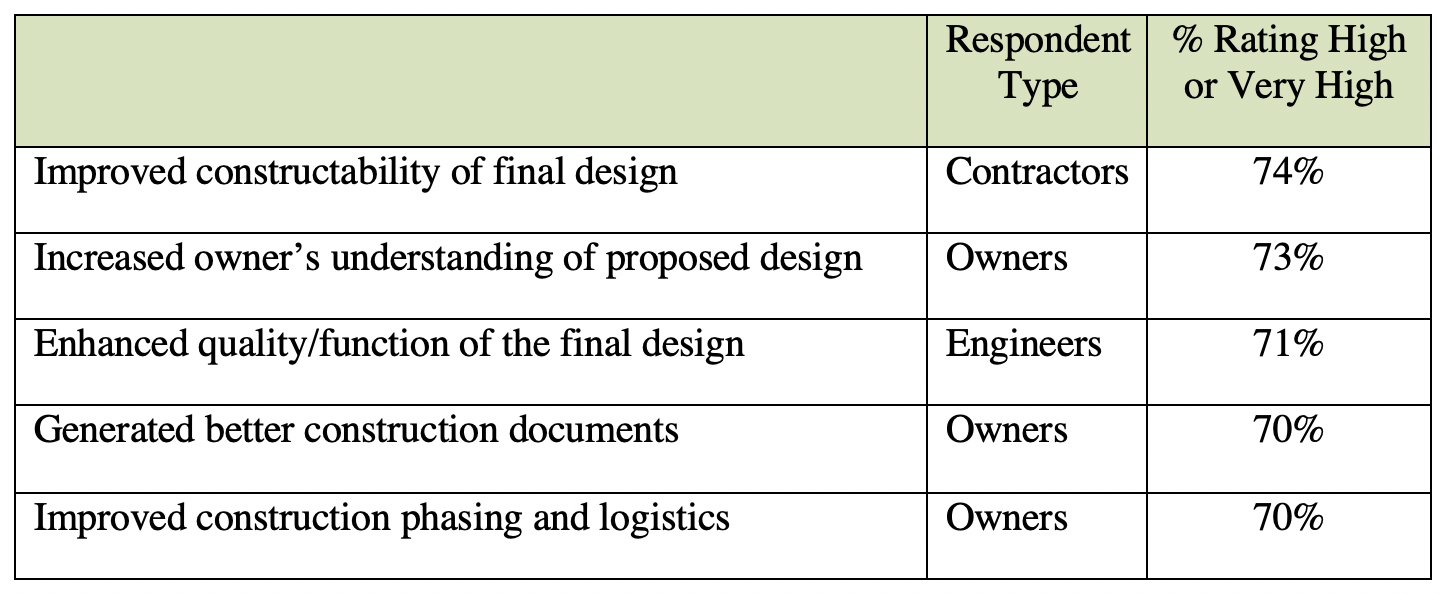Building Information Modeling (BIM)
New CommercialWhat is Building Information Modeling (BIM)?
Building Information Modeling (BIM) forms a digital representation of a building’s physical and functional characteristics and calculates information about the facility that can be used by all project team stakeholders to make decisions about the design, construction, maintenance, and operations of a building throughout its life-cycle.[1] Combining graphical information, such as plans and elevations, and nongraphical information, such as costs, specifications, schedules and maintenance requirements, into a BIM model results in a single source of information.[2]

Figure 1 – Building Information Modeling (BIM) from the US General Service Administration. (Source: GSA)
How to Implement Building Information Modeling (BIM)
Designate a ‘Project BIM Manager’ or a lead design and a lead construction ‘Project BIM Manager’ with knowledge and experience working with BIM and selected software. Provide ongoing BIM training to all building stakeholders responsible for inputting, extracting, modifying, and analyzing the data (see Integrated Design Process and Energy Modeling).
The National Institute of Building Sciences’s, The National Building Information Modeling Guide for Owners (NBGO),guides building owners on how to incorporate BIM into internal policies and contract documents.[3]
Example
Metlife Stadium, East Rutherford, NJ.
The Metlife Stadium project team used BIM to track and monitor supply chain performance, including production status, quality control, delivery, site preparation and installation of over 3,200 pre-cast concrete panels, reducing the construction period by 10 days and saving $1 million.[4]
BIM was used in the construction of the Information Technology Laboratory to overlay design, construction, and subcontractor information, and identify and resolve potential issues of conflict before costly rework was necessary.[5]
Benefits
BIM coordinates information sharing among building stakeholders across multiple project phases that result in more informed decision making and eliminates the re-gathering and re-formatting of building information.[6]BIM also serves as a “clash detection tool,” by identifying potential design, construction, and operational inconsistencies, and cuts costs and reduces waste by avoiding rework.[7]
The following table highlights the results of a survey conducted by Dodge Data and Analytics on the benefits of BIM.
Table 1. Five Top-Rated Positive Impacts of BIM[8]

Table 1. Five Top-Rated Positive Impacts of BIM
Costs
The cost of implementing BIM varies widely, depending on the project team’s expertise using BIM, the complexity of the project, and other building process considerations. Costs include training, software, and organizational changes required to implement BIM technology.[9] Lower building costs and efficient construction timelines associated with BIM projects can often offset these upfront costs.[10]
Resiliency
BIM enhances the resilience of the built environment and construction industry in the “pre-disaster phase and post-disaster phases.”[11] In the design phase, BIM can conduct scenario forecasting to predict the performance of a facility during emergencies, such as fire, flood, evacuation, and others.[12] BIM also can enhance the post-disaster phase by providing building information to first responders and allowing them to direct building occupants to the nearest exit.[13]
[1]Computer Integrated Construction Research Program. BIM Project Execution Planning Guide – Version 2.1. Pennsylvania State University (2011). http://bim.psu.edu (accessed April 17, 2018).
[2]NIST. National BIM Guide for Owners (2012). http://c.ymcdn.com/sites/www.nibs.org/resource/resmgr/nbgo/Natl_BIM_Guide_for_Owners.pdf (accessed March 7, 2018)
[3]NIST. National BIM Guide for Owners (2012).
[4]Skanska. Metlife Stadium Sustainability Case Study. https://group.skanska.com/projects/57101/MetLife-Stadium/sustainability (accessed May 2, 2018).
[5]Jonathan Boone. 2017. “Building Information Modeling becomes everyday business.” US Army Corps of Engineer Research and Development Center, Information Technology Laboratory. https://www.erdc.usace.army.mil/Media/News-Stories/Article/1172517/building-information-modeling-becomes-everyday-business/ (accessed June 21, 2018).
[6]National Institute of Building Sciences – Whole Building Design Guide – Building Information Modeling (BIM) https://www.wbdg.org/building-information-modeling-bim (accessed June 21, 2018).
[7]Jonathan Boone. 2017. “Building Information Modeling becomes everyday business.” US Army Corps of Engineer Research and Development Center, Information Technology Laboratory. https://www.erdc.usace.army.mil/Media/News-Stories/Article/1172517/building-information-modeling-becomes-everyday-business/ (accessed June 21, 2018).
[8]Dodge Data and Analytics. (2017). Measuring the Impact of BIM on Complex Buildings. https://www.usa.skanska.com/siteassets/what-we-deliver/services/bim–vdc/value-to-clients/measuring-the-impact-of-bim-on-complex-buildings-2015f.pdf (accessed March 7, 2018).
[9]Dippold, Cory. “Effective Implementation of BIM.” November 26, 2008. Engineering News-Record. http://enr.construction.com/opinions/viewPoint/2008/1126-BIMImplementation.asp (accessed March 6, 2018).
[10]National Institute of Building Sciences. Journal of Building Information Modeling. https://www.epa.gov/green-engineering (accessed March 7, 2018).
[11]Sertyesilisik, Begum. 2017. Building Information Modeling as a Tool for Enhancing Disaster Resilience of the Construction Industry. Technical University of Ostrava, Safety Engineering Series. 12(1): 9-18.https://www.degruyter.com/downloadpdf/j/tvsbses.2017.12.issue-1/tvsbses-2017-0002/tvsbses-2017-0002.pdf (accessed March 7, 2018)
[12]Kreider, Ralph G., and Messner, John I. (2013). “The Uses of BIM: Classifying and Selecting BIM Uses.” Version 0.9, September, The Pennsylvania State University, University Park, PA, USA. http://bim.psu.edu
[13]Sertyesilisik, Begum. 2017.
